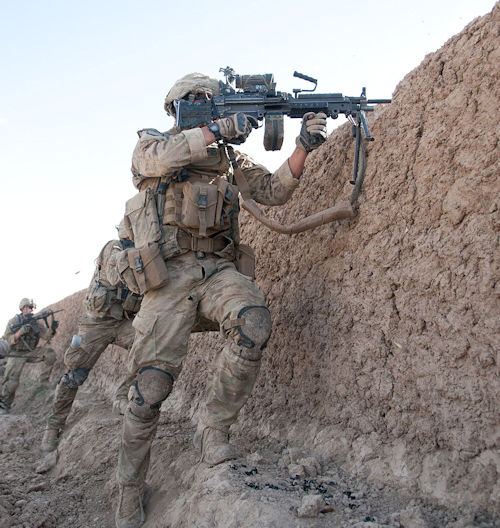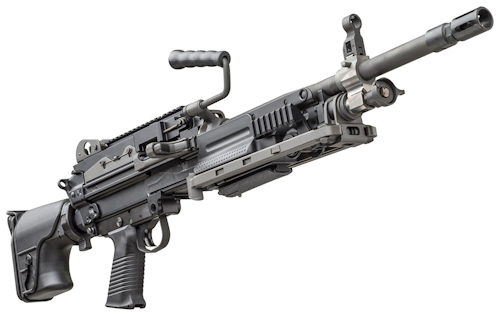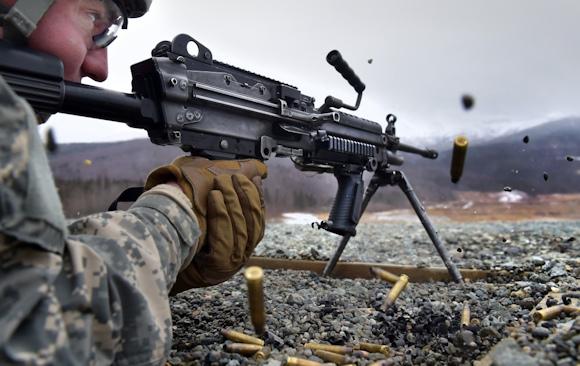Designed by Ernest Vervier in the 1977, the MINIMI of the Fabrique Nationale de Herstal (FNH) still represents a reference point for the category of light machine guns (LMG) in the likes of 5,56x45. When NATO armies began the transition from the 7,62x51 caliber to the 5,56x45 caliber, the Mini Mitrailleuse Belgian was the only one on the market.
In addition to being able to use M-27 disintegrable mesh tapes, MINIMI has the possibility to use STANAG carton loaders, the same as the M-16 / M-4 series, which can be inserted in the special filler placed under the supply. However, in the various operating scenarios in which MINIMI was used, the machine-gunners preferred to use the box-type loader from 200 strokes, in order to guarantee a sustained saturation fire.
The rifling of the barrel, initially, was 305 mm, optimized for the use of the M-193 shot by 55 grains; then it went to a scratch of 178 mm for the new bullet SS-109 / M-855 from 62 grains, which later became the standard blow of NATO.

In the 1984 the US Army officially adopts the MINIMI, under the name M-249, which was followed by some modifications of the weapon: use of a polymer stock; new hydraulic buffer; unique position of gas regulation; flame arrester similar to that of the M-16 / M-4. Changes then extended to the entire production of the FN Herstal.
Obviously the versions for the Special Forces could not be missing: first the SPW (Special Purpose Weapon), more compact than the original model and without the alternative of the box loader (soft pack from 50 / 100 shots) and a short barrel type for. With this set-up, the weight drops to about 5,7 kg.
The Mk-46 version was requested by NAVSPECWAR (Naval Special Warfare Command), with a new rod with a quadrant rail and a titanium bipod.
However, the Afghan experiences had highlighted the poor ballistic performance of the 5,56x45 caliber. Because of this, the USSOCOM (Special Operations Command) issued in the 2002 a requirement for a Light Weight Machine Gun (LWMG) in the likes of 7,62x51.
The FN responded to this requirement by realizing a model in 7,62 of the Mk-46, the Mk-48. In 2003, with the USSOCOM adoption of the Mk-48 Mod. 0 version, the interest in a light machine gun like the 7,62x51 began to spread in other military environments.
But it is in the 2010, with the Soldier Enhancement Program and Rapid Fielding Initiative, that the changes dictated by the experiences in the Afghan and Iraqi theaters - where among others the 5,56x45 caliber showed poor ballistic qualities - push the FN to produce the Mk version- 3.
The changes imposed by the Americans concern the introduction of a new telescopic stock, similar to that of the M-4 rifles, the installation of a Picatinny slide, to allow the assembly of the optics, the possibility to mount a handle under the cover; a new bipod and flame-down, a synthetic fabric tape holder (named soft pack).

In the 2013 the FN officially presented the new MINIMI Mk-3 series, in the calibres 5,56x45 and 7,62x51 (photo).
The MINIMI Mk-3 can also be obtained by converting previous versions, using special kits made by the FN. There is also one that allows conversion to 5,56 for the MINIMES in the 7,62 caliber which includes barrel, shutter holder unit, power box and new breech cover.
There are three versions of the MINIMI 7,62x51: Tactical, Para and Standard. The length of the barrel is unique for all models, equal to 422 mm. Instead the total length of the weapon varies according to the type of football used. The Standard version, which uses fixed polymer stock, is 1.015 mm long and weighs 8,5 kg. The speed of shooting is about 800 strokes / minute while the maximum range is 1.000 meters.
The MN-3 in the likes 7,62x51 could equip the Italian Army infantry squads, instead of the 5,56x45 version. The MINIMES in the upper caliber would allow a substantial increase in the firepower of the rifle teams, indispensable in the current operational scenarios.

Photo: US Air Force / US DoD / FN Herstal












